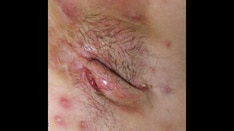Abstract and Introduction
Abstract
Introduction: Hidradenitis suppurativa can be a debilitating condition, particularly in the pediatric population. Axillary hidradenitis can be particularly challenging because of the risk of scar contracture and limited range of motion after definitive resection and reconstruction. A dermal regeneration template (DRT) and skin grafting have been used to reduce scar contracture in other areas of the body and may benefit this population.
Objective: This case series retrospectively reviewed and evaluated outcomes using DRT and skin grafting for axillary hidradenitis reconstruction to report the authors' initial experience.
Materials and Methods: After institutional review board approval, a retrospective review was conducted of a single surgeon's experience for all patients undergoing axillary hidradenitis resection and immediate reconstruction with DRT and skin grafting from 2015 through 2018. Preoperative characteristics, surgical details, and postoperative results were collected.
Results: Five patients undergoing 7 procedures were eligible for inclusion. The average age at the time of surgery was 18.2 years. Patients underwent an average of 4.9 negative pressure wound therapy changes prior to skin grafting. No complications, DRT loss, or skin graft loss occurred. All patients were reported to have normal range of motion of the surgically managed extremity after skin grafting. The average follow-up was 273.4 days after the last procedure. As of this writing, no patients had experienced any recurrence of hidradenitis in the surgically managed axilla.
Conclusions: The use of DRT and subsequent skin grafting for the definitive management of axillary hidradenitis resulted in no recurrence and full range of motion of the affected extremity without complications. Surgeons should consider using this method of reconstruction for axillary hidradenitis, particularly in the pediatric population.
Introduction
Hidradenitis suppurativa is a debilitating condition characterized by chronic inflammation of apocrine glands, most commonly in the axillary, perineal, and anorectal regions, resulting in symptoms ranging from recurrent nodules and abscesses to sinus tracts and hypertrophic scarring and contractures.[1,2] Hidradenitis most commonly occurs in adulthood, and children in whom hidradenitis is diagnosed are more likely than adults to have hormonal abnormalities, obesity, and a family history of hidradenitis.[2] The Hurley staging system is commonly used to describe hidradenitis, with mild cases (stages I and II) being treated with nonsurgical modalities such as topical antibiotics, oral antibiotics, biologics, laser therapy, and botulinum toxin.[2–5] For severe cases (stage III), wide excision and reconstruction remain the mainstays of treatment to minimize recurrence.[6,7]
Because of the relatively low incidence of hidradenitis in the pediatric population, literature on treating this population is sparse. For this study, the authors sought to evaluate their experience treating axillary hidradenitis at a tertiary pediatric hospital using a dermal regeneration template (DRT) (Dermal Regeneration Template; Integra LifeSciences) and split-thickness skin grafting, with the hypothesis that this method of reconstruction results in acceptable functional outcomes with a low recurrence rate.
Wounds. 2022;34(2):43-46. © 2022 HMP Communications, LLC










